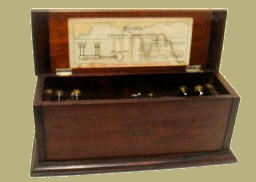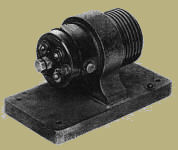|
Electromechanical amplifier (carbon amplifier) |
|
Black ebonite base with the
speaker transformer hidden inside and on top of the
carbon amplifier itself. |
 |
|
The input signal is fed through two
connections to a coil, causing a metal rod (acting as a
diaphragm) to
vibrate in rhythm with the sound signal.
The rod is connected to a carbon microphone that is
connected to a 3 volt battery.
The current is amplified and fed via a transformer to a
connected horn loudspeaker.
The Brown company already came up with such a system,
both as a single unit and built into a horn loudspeaker,
the Crystavox.
In 1926 Brown came up with a version that amplified the
sound an extra time via an extra coil set and carbon
microphone.
This Brown Crystal Amplifier with two
microphones from 1926 is shown on the right. |
|
The advantage of this type of amplifier
was that it was a lot cheaper than a tube amplifier;
38 shillings versus about 10 pounds.
A disadvantage was that the distortion
was somewhat greater. |
|
 |
The electromechanical amplifier was
invented in 1904 by the American Bell engineer Herbert
E. Shreeve (he was born in England).
He used the system (left) to amplify the
telephone signals between New York and Chicago. |
The Microphone Bar Amplifier can amplify the
weak signal from a crystal receiver. It operates on two
1.5 volt dry cells. It was made by New Wilson Electrical
Manufacturing Co., Ltd., 18 Fitzroy Street, Euston Road,
London W1. |
|
The original price was 38 shillings. |